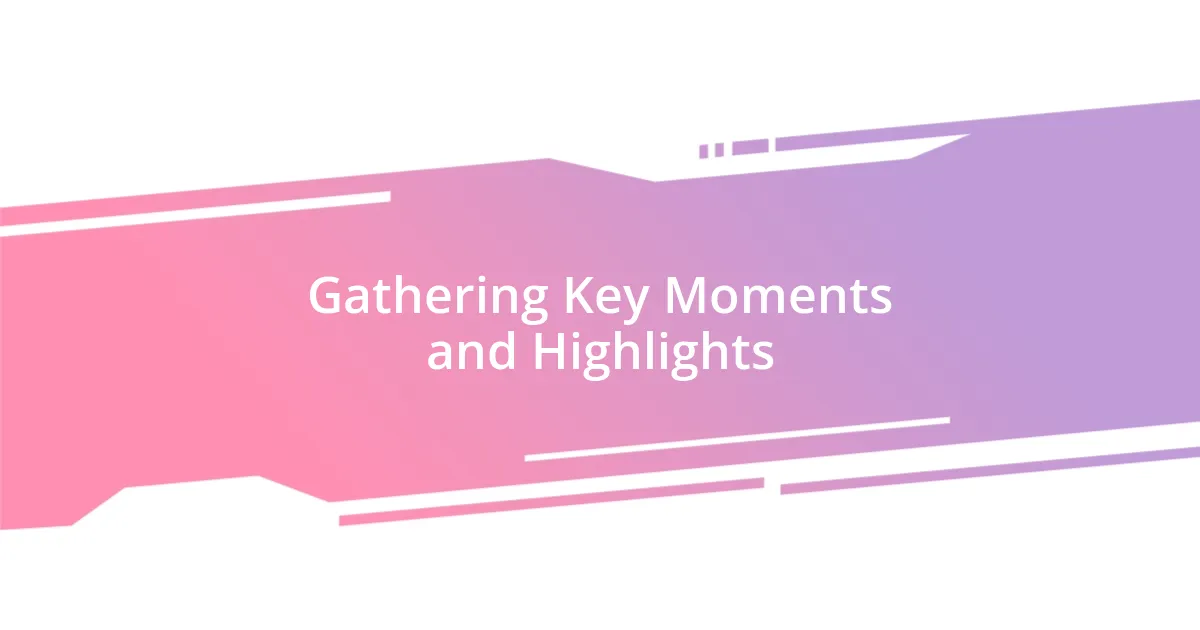Key takeaways:
- Recaps enhance understanding by reflecting on both achievements and challenges, transforming memories into valuable lessons.
- Incorporating sensory details, dialogue, and contrasting emotions enriches narrative elements, making recaps engaging and relatable.
- Utilizing visuals and media, such as photos and videos, creates multi-dimensional stories that foster emotional connections.
- Encouraging audience interaction through questions and feedback enhances the recapping experience, creating a shared communal bond.

Understanding the Importance of Recaps
Recaps hold significant value in our lives, serving as a moment of reflection that can deepen our understanding of experiences. I remember sitting down after a particularly challenging project at work, where I took time to review what went well and what didn’t. It was in that quiet moment of reflection that I realized the lessons learned were just as important as the successes themselves.
When we take the time to recap, we not only celebrate our achievements but also confront our challenges. I often find myself asking, “What could I have done differently?” Each time I ponder this question, I gain a richer insight into my decision-making process and how it shapes my future choices. This practice transforms mere memories into valuable lessons that stick with me.
Moreover, recaps can foster a sense of closure. After a long vacation, I like to recap my adventures, reliving the joy of each moment while processing any disappointments. It’s amazing how examining both the highs and lows can create a deeper appreciation for life and its unpredictability, making me excited for what’s to come next.

Gathering Key Moments and Highlights
Gathering key moments and highlights is an essential step in crafting meaningful recaps. I often jot down memorable experiences right after they happen; this way, I capture the emotions and details while they’re still fresh. For instance, after an exhilarating hike, I would quickly scribble down how the sunlight pierced through the trees, illuminating the path, or how the sound of my footfalls on the gravel made me feel grounded in the moment. These snapshots of my experiences help me distill the essence of each event later on.
- Here are some effective ways I gather key moments:
- Journaling: I frequently use a notebook to write about experiences daily.
- Voice Notes: When I’m on the go, I record quick voice memos to capture feelings before they fade.
- Photographs: I take candid photos, not just posed ones, that evoke the true spirit of an experience.
- Mind Mapping: I create visual aids that connect different aspects of an experience, allowing me to see relationships and themes.
- Social Media Posts: Reflecting on past posts triggers memories and feelings that are worth noting.
Through these methods, I can distill my experiences into their most potent forms, allowing for a richer and more meaningful recap process later on.

Crafting Engaging Narrative Elements
Crafting engaging narrative elements requires blending facts with personal experiences to create a compelling story. When I recount a significant event, I focus on the sensory details—I think back to a lively dinner party I attended last summer. The aroma of delicious food wafting through the air and the sound of laughter echoing around the table transport me back to that moment, making the narrative more vivid for anyone listening. By weaving together these sensory aspects, I find that my recaps become not just mere memories but vivid journeys that others can experience alongside me.
I often utilize dialogue in my recaps to bring interactions to life. For example, during a family gathering, my niece exclaimed, “Auntie, tell me a story!” This simple request ignited a rich exchange that captured the warmth of our time together. By sharing these snippets of conversation, I engage my audience, allowing them to feel connected to the emotions of the moment. It’s amazing how well-chosen words can encapsulate the essence of interactions and create a stronger bond with my listeners or readers.
Additionally, I like to draw on contrasting emotions to provide depth to my narratives. I vividly recall a day that started off stressful with a looming deadline, but ended joyously as my friends surprised me with a celebratory dinner. Describing the anxiety of the morning juxtaposed with the exhilaration of the evening not only entertains but also invites reflection on how life can shift unexpectedly. I believe this interplay of emotions invites others to relate their own experiences to my story, making it even more engaging.
| Narrative Element | Description |
|---|---|
| Sensory Details | Utilizes sights, sounds, and smells to transport the audience into the story. |
| Dialogue | Incorporates conversations to bring characters and interactions to life. |
| Contrasting Emotions | Highlights the interplay of different feelings to create depth and relatability. |

Incorporating Visuals and Media
Incorporating visuals and media into my recaps has transformed the way I convey my experiences. For instance, after a day at the beach, I love compiling a vibrant slideshow that captures the golden sunsets, splashes of waves, and candid moments with friends. This not only reinforces the emotions I felt during the day but also gives my audience a front-row seat to the adventure, making it far more engaging.
I’ve found that adding short video clips can really elevate my recaps. During a recent music festival, I recorded snippets of the performances mixed with the cheers of the crowd. The energy and excitement captured in those few seconds can profoundly resonate with anyone who watches—it’s like sharing the pulse of the event itself. Isn’t it fascinating how a single image or clip can evoke memories that words sometimes struggle to express?
Combining these elements helps me create multi-dimensional stories that are not just informative but also resonate emotionally. I remember once sharing a photo of my friend laughing uncontrollably during a game night, which sparked a wave of nostalgia among our group. Everyone immediately chimed in with their own memories, creating a connection that transcended time and distance. This interplay of shared visuals and collective memories turns my recap into a communal experience, leaving a lasting impression on all who engage with it.

Sharing Your Recaps Effectively
Sharing your recaps effectively is all about embracing authenticity. I remember once sharing a story about a spontaneous road trip I took with friends. Instead of just detailing the itinerary, I included the delightful chaos of packing at the last minute and our impromptu karaoke sessions in the car. Have you ever experienced that exhilarating feeling of freedom during a long drive? Capturing those moments made my audience feel like they were right there with us, riding along.
When I share recaps on social media, I like to ask my friends for their input. During a memorable hiking trip, I posted a photo of a stunning viewpoint and asked, “What was your favorite part of the hike?” The responses flooded in, turning my solitary experience into a lively conversation about our different perspectives. It was rewarding to see how one recap became a means for everyone to relive those moments together, sparking shared joy.
I also pay attention to timing when I share my recaps. For example, I tend to post photos and stories from events while the energy is still fresh—often that same night! It creates a sense of immediacy. I find that the laughter and joy I felt in those moments come through more vividly when I share them right away. Have you ever captured a moment that simply fizzled when shared too late? There’s something magical about sharing experiences in real-time that helps others feel included and engaged.

Encouraging Audience Feedback and Interaction
Engaging with my audience genuinely is one of the highlights of my recapping process. I often relate my stories to broader themes, like during the last family reunion when I shared a hilariously embarrassing moment with my cousin. I asked everyone, “What’s your most embarrassing family story?” The flood of laughter and responses not only made my post feel more like a conversation but also created a delightful tapestry of shared experiences. Isn’t it amazing how such moments can break the ice and forge connections?
I find that encouraging feedback enhances the emotional tapestry of my recaps. After attending a workshop, I posted a photo of the inspiring speaker with the question, “What part of this spoke to you?” I was pleasantly surprised by the flood of thoughtful responses. Each reply opened up a new thread of discussion, inviting different interpretations and insights that I hadn’t originally considered. It’s those shared reflections that transform a simple recap into a rich dialogue, reminding me that everyone has a unique perspective worth celebrating.
Creating polls or questions in my online stories has become a favorite way to foster interaction. At a recent art show, I shared snapshots of various artworks and added a poll asking, “Which piece resonated with you the most?” The ensuing conversation brightened my day; people expressed their diverse emotions and opinions, showing me that art isn’t just about what you see—it’s also about how it makes you feel. It’s gratifying to know that my experiences could spark those feelings, and it inspires me to keep sharing. What about you? How do you encourage feedback from your audience?














